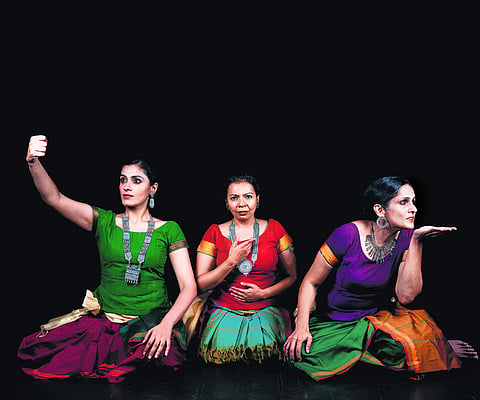
- LIFESTYLE
- FASHION
- FOOD
- ENTERTAINMENT
- EVENTS
- CULTURE
- VIDEOS
- WEB STORIES
- GALLERIES
- GADGETS
- CAR & BIKE
- SOCIETY
- TRAVEL
- NORTH EAST
- INDULGE CONNECT

The epic Ramayana has inspired a bevy of productions by a number of playwrights from across the country over the years. But it’s not often that we see the men take a backseat, and the women characters, besides Sita, at the forefront in a script. JustUs Repertory’s Gowri Ramnarayan has done exactly this in her upcoming play. Titled What She Said — Six Voices from The Ramayana, the play explores the stories of six women characters, who played significant roles in the journey leading up to the battle between Prince Rama and the king Ravana, and faced a number of struggles and challenges with determination and courage.
Starring Sunandha Raghunathan, Akhila Ramnarayan and Aarabi Veeraraghavan, it puts the spotlight on the characters — Urmila, Manthara, Surpanakha, Mandodari, Tara and Shanta. Talking about the essence of her play, Gowri says, “I saw how they faced their own struggles for survival. I discovered that their problems are our problems, and heard them raising disturbing questions that are very much alive in our contemporary world. But exploring those issues is emancipatory, and I hope that searching for answers together with our audience will bring insight and understanding.” Ahead of her play’s premiere at Kalakshetra next week, the director talks to us about what inspired her to come up with this script, and her thoughts on the beautiful versatility of the Ramayana. Excerpts:
What inspired you to do What She Said?
I have always been fascinated by the less seen, half-heard and little known. The real stories come from these sources. Particularly from women who have been shunted to the wings through the ages. That’s a vantage point for keener observation and deeper understanding. Women can be both practical and idealistic. I find their world view more intellectually stimulating and more emotionally intriguing. What She Said is what I heard from them — their stories are more sharp-focused because the view is ‘off-centre’. More specifically, What She Said takes a close look at six women in supporting roles in the Ramayana, shaping them as individuals in their own right, believing that their stories are both unique and universal — certainly no less important or less intense than the saga of the protagonist, Sita. I don’t see them as relics from ancient legend, but as those living in the people around us, within each one of us — right here, right now.
In your script, are there any deviations from or additions to the original storylines of the individual characters in your play?
Every language and dialect in India has its own version of the Ramayana. Which is the original one? I would say — “All of them”. The epic continues to grow with modern versions and revisions. Valmiki has outlined characters for me to the colour, shade and flesh out — to say what I have to say in my own time. My actors add to this feminist narrative with their own craft and experiences. Additionally, the music and the lights bring out their nuances.
How challenging was it to connect stories of six different characters and mould them into a single script?
Connecting stories is a matter of craft. The real challenge is to write a play to provoke myself, my actors, and the audience, and to think about all the disturbing issues that we are grappling with today — loss, betrayal, hatred, fear and violence. After all, that is what the Ramayana does — it overwhelms us with questions. Such agitation is cathartic and emancipatory.
What kind of dialogues and music can we expect?
I try to use dialogues to convey the rhythm of thought and the rush of feeling. The actors respond to the words with their bodies and minds. Praveen Sparsh and Shreya Devnath have layered the images and feelings with the music they have composed and will perform live.
What kinds of set and costumes have been designed?
I depend on B Charles’ minimalist lighting to create different spaces and moods. Kirthana Chitra-Ravikumar is helping to design with earthy colours and minimal tailoring, while Manjushaa Jewellery has provided aesthetic ornaments.
What are your fondest memories with regards to reading the Ramayana? How much did it influence your approach to storytelling and drama?
One day, returning from work, I was startled to see my mother, sister and daughter weeping together. My daughter sobbed, “Sita!”My sister cried, “Imprisoned!” Turned out, my mother was telling them the story of Sita’s abduction. There was no stage there, and no lights, sets, costume, background score or actors. Just one storyteller transporting listeners to an imaginary space, to experience overwhelming compassion for the wronged, the helpless and the oppressed. This was agitation — while restoring a sense of values. This is the magic of storytelling that continues to thrill me!
December 8, 6 pm. At Kalakshetra Foundation. Tickets available online.